I remember the first time I tried bo ne, the sizzling Vietnamese beef plate that has become one of my all-time favorite dishes. The aroma of marinated beef, herbs, and vegetables filled the air as the plate arrived at my table, and I couldn’t wait to dig in.
The sizzling sound of the hot plate, the tender beef, the perfectly cooked egg, and the tangy dipping sauce – all combined to create a mouthwatering experience that I will never forget. It was a culinary adventure that introduced me to the rich flavors and textures of Vietnamese cuisine, and ever since that first taste, I have been hooked on bo ne.
Yelo’s blog will explore the history, ingredients, preparation, and cultural significance of bo ne, as well as the variations and health benefits of this iconic dish. Whether you’re a foodie or simply curious, get ready to discover the sizzling flavors of bo ne!
What is bo ne?
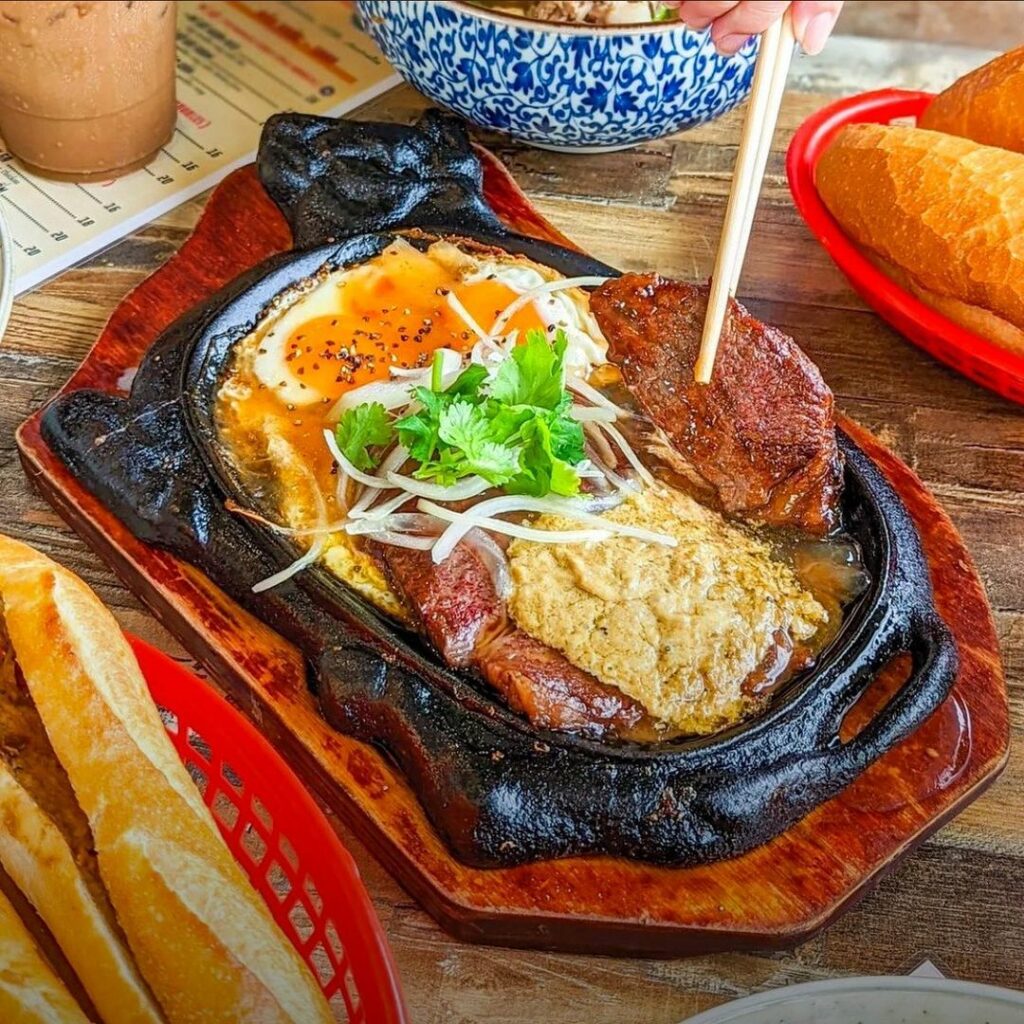
Bo ne is a sizzling Vietnamese beef plate that has become one of the most popular and beloved dishes in Vietnamese cuisine. It is a flavorful and hearty dish that features marinated beef, vegetables, and herbs, topped with a perfectly cooked egg and served with a tangy dipping sauce.
Originating in Vietnam, bo ne has a rich history and cultural significance. The dish’s name, bo ne, is derived from the French word “beefsteak,” reflecting the influence of French colonialism in Vietnam. However, the dish has evolved over time to become a unique Vietnamese creation, combining French and Vietnamese flavors and techniques.
Bo ne is believed to have originated in the southern Vietnamese city of Vũng Tàu, where it was popular street food among locals and tourists alike. From there, it spread throughout the country and has become a staple in Vietnamese cuisine.
In Vietnamese cuisine, bo ne holds significant cultural and social significance. It is often served during special occasions, celebrations, and family gatherings, bringing people together over a delicious and hearty meal. The dish’s popularity has also made it a symbol of Vietnamese culinary culture, representing the fusion of traditional Vietnamese ingredients and French influences.
Bo ne Vietnamese is a sizzling beef plate and has become a beloved dish in Vietnamese cuisine. Its unique blend of French and Vietnamese flavors and techniques, as well as its cultural significance, make it a must-try for anyone interested in exploring the rich and diverse world of Vietnamese cuisine.
Why bo ne is so popular?
Bo ne’s popularity can be attributed to several factors. Firstly, it is a delicious and hearty dish that combines the rich flavors of marinated beef, vegetables, herbs, egg, and dipping sauce, all sizzling on a hot plate. The combination of flavors and textures creates a mouthwatering experience that is hard to resist.
Another reason for bo ne’s popularity is its versatility. It can be served as a main dish or as a snack, making it suitable for any time of day. It can be paired with rice, or bread, or eaten on its own, giving diners the flexibility to customize their meal according to their preferences.
Furthermore, bo ne’s affordability and accessibility have contributed to its popularity. It is a relatively inexpensive dish that can be found in many restaurants and street food stalls throughout Vietnam. It is also easy to make at home, making it a popular choice for home-cooked meals.
Bo ne recipe
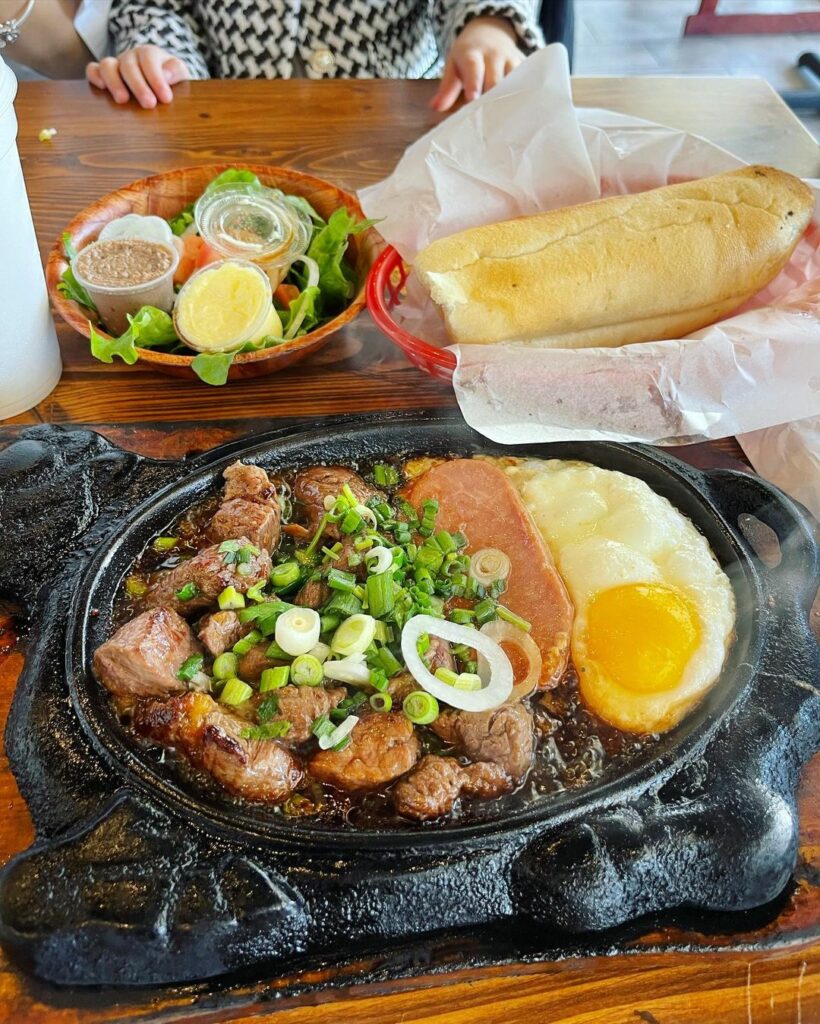
Bo ne is traditionally served on a hot plate, but if you don’t have one, you can use a regular skillet or pan. Also, the recipe calls for flank steak, but you can use other cuts of beef such as sirloin or ribeye if desired. Here is a sample recipe for bo ne
Cooking note
- Yield: 2
- Prep Time: 15 minutes
- Cook Time: 15 minutes
- Total Time: 30 minutes
- Course: Main Dish
- Cuisine: Vietnamese
- Equipment: Hot plate or skillet/pan, tongs, spatula
Ingredients
- 1 lb flank steak, sliced thinly against the grain
- 1 tbsp vegetable oil
- 2 cloves garlic, minced
- 2 tbsp soy sauce
- 1 tbsp oyster sauce
- 1 tbsp sugar
- 1/2 tsp black pepper
- 1 egg per serving
- 1/2 onion, sliced
- 1 tomato, sliced
- 1 cucumber, sliced
- 1/4 cup cilantro, chopped
- Salt and pepper to taste
How to make bo ne, step-by-step?
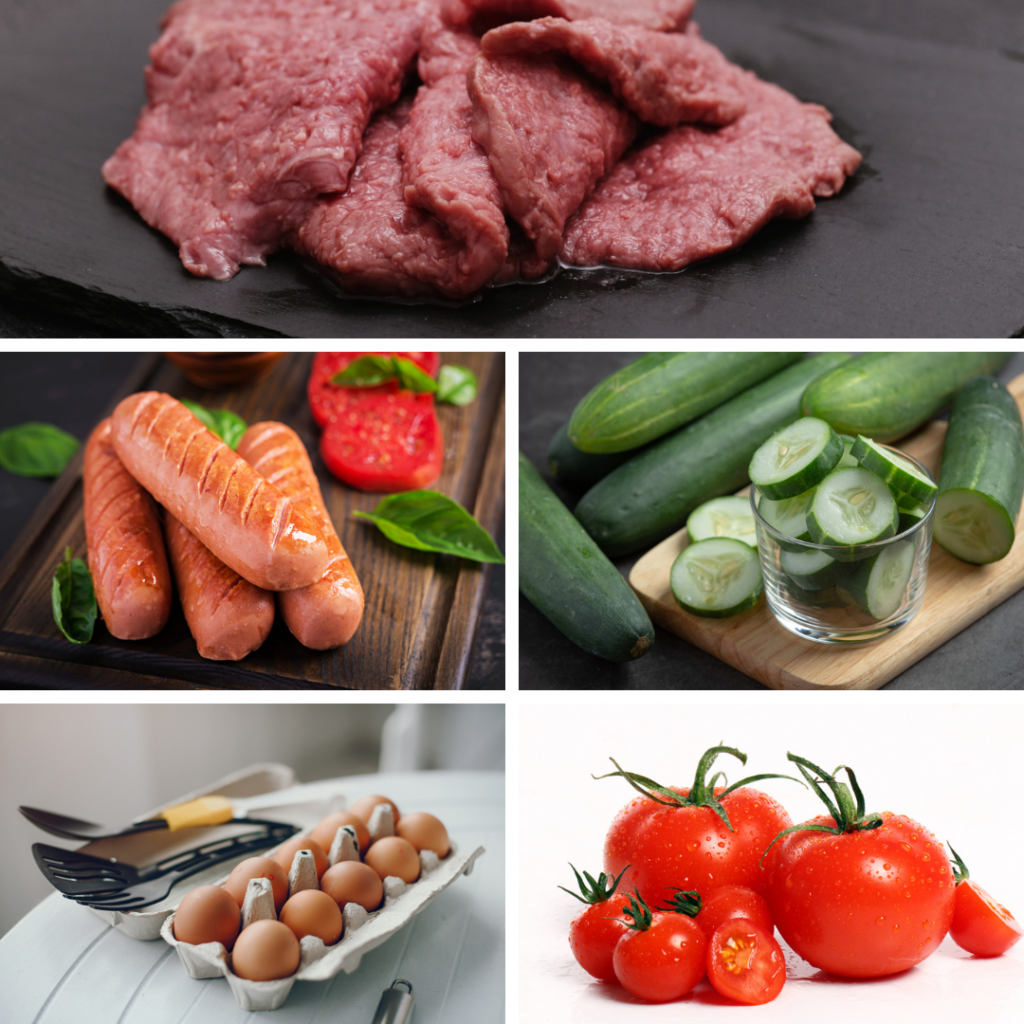
Here’s a step-by-step guide on how to make bo ne:
Preparing bo ne
- Start by thinly slicing 1 pound of flank steak against the grain. Set aside.
- In a mixing bowl, combine 2 tablespoons of soy sauce, 1 tablespoon of oyster sauce, 1 tablespoon of sugar, 1/2 teaspoon of black pepper, and 2 cloves of minced garlic. Stir until the sugar dissolves.
- Add the sliced flank steak to the mixing bowl and toss to coat. Let the meat marinate in the mixture for at least 30 minutes.
Marinating the beef
- Heat a hot plate or skillet over medium-high heat.
- Add 1 tablespoon of vegetable oil and swirl to coat the surface.
- Use tongs to transfer the marinated beef to the hot plate or skillet. Sauté the beef for 2–3 minutes on each side until browned and sizzling.
Sautéing the beef
- Using tongs, move the cooked beef to the sides of the hot plate or skillet to make room for the egg.
- Crack 1 egg in the center of the hot plate or skillet and cook to your desired doneness.
- Season the egg with salt and pepper.
Cooking the egg
- Slice 1/2 onion, 1 tomato, and 1 cucumber into thin slices.
- Arrange the sliced vegetables around the hot plate or skillet.
- Garnish with chopped cilantro.
Making bo ne involves marinating the beef, sautéing it on a hot plate or skillet, cooking an egg, and assembling the plate with sliced vegetables and herbs. With this step-by-step guide, you’ll be able to create a delicious and flavorful bo ne at home.
How to serve and eat bo ne?
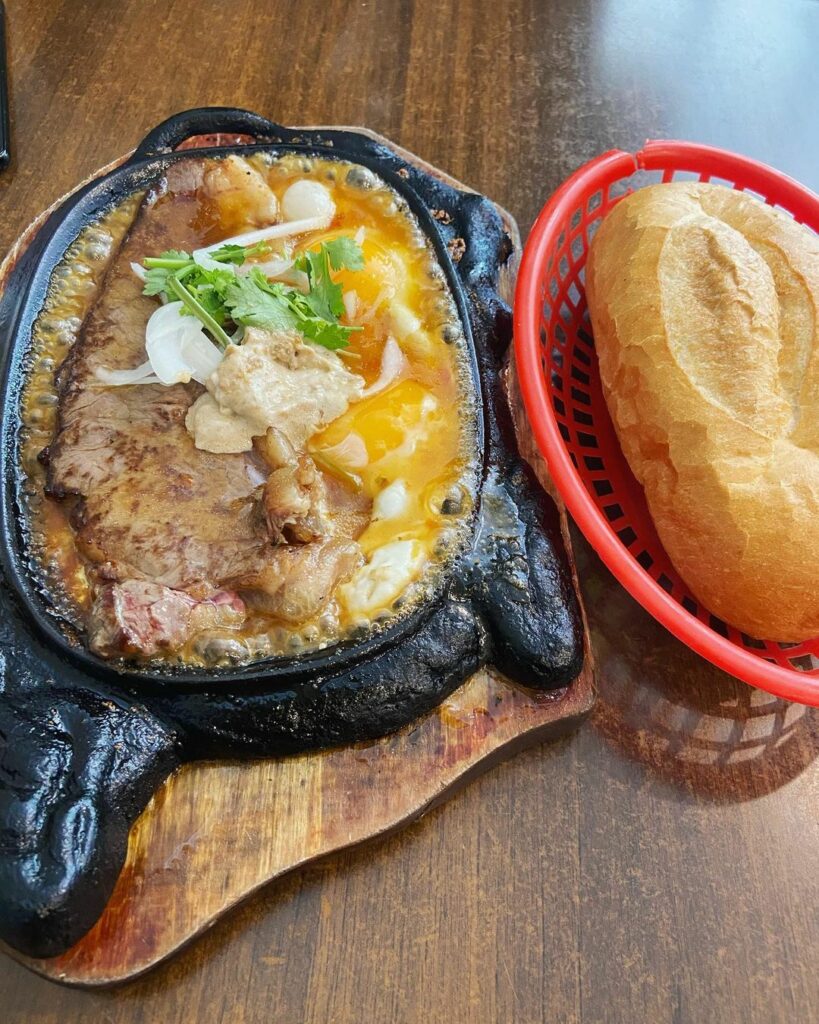
Here’s a guide on how to serve and eat bo ne:
Plating the dish
- Heat up a hot plate or skillet over high heat.
- Sauté the marinated beef until browned and sizzling.
- Add sliced onions, tomatoes, and cucumbers around the edge of the hot plate or skillet.
- Crack an egg in the center of the hot plate or skillet and cook to your desired doneness.
- Garnish with chopped cilantro and serve hot.
Pairing with rice or bread
Bo ne can be paired with rice or bread to create a satisfying and filling meal. For a classic pairing, serve bo ne with a side of steamed rice. For a more unique twist, try pairing bo ne with a freshly baked banh mi baguette.
Banh mi bo ne is popular street food in Vietnam that features bo ne served on a crusty baguette with pickled vegetables and mayonnaise.
Eating etiquette
When eating bo ne, it is customary to use a fork and knife. Use the fork to cut the beef and vegetables into smaller pieces, and the knife to help scoop them onto your fork.
You can also use a piece of baguette to scoop up the beef and vegetables or to soak up the runny egg yolk. When eating bo ne pan, which is bo ne served on a pan instead of a hot plate, be careful not to touch the hot surface of the pan.
To serve and eat bo ne plate the dish with sautéed beef, vegetables, and a fried egg, and serve with a side of rice or bread. Pairing bo ne with banh mi is a popular option. When eating, use a fork and knife, and be careful when eating bo ne pan. Enjoy the delicious and sizzling flavors of bo ne.
Table of nutrient facts bo ne
Here’s a table of nutrient facts for bo ne:
| Nutrient | Amount |
| Calories | 455 |
| Protein | 32g |
| Fat | 26g |
| Saturated Fat | 8g |
| Carbohydrates | 25g |
| Fiber | 3g |
| Sugar | 12g |
| Cholesterol | 290mg |
| Sodium | 1034 mg |
| Vitamin C | 23% DV |
| Iron | 26% DV |
| Calcium | 4% DV |
This table provides information on the nutrient content of a typical serving of bo ne Vietnamese. It is high in protein and fat, with a significant amount of cholesterol and sodium. It also contains a moderate amount of carbohydrates, fiber, and sugar. Bo ne is a good source of vitamin C and Iron, but only contains a small amount of Calcium. As with any dish, it is important to consume bo ne in moderation as part of a balanced diet.
Variations of bo ne
Bo ne Vietnamese has several variations that offer unique flavors and textures. Here are a few examples:
Different types of beef cuts
While bo ne is traditionally made with flank steak, it can also be made with other cuts of beef, such as sirloin or ribeye.
Each cut of beef offers a slightly different texture and flavor, so experimenting with different cuts can add a new dimension to the dish.
Regional variations
Bo ne has regional variations throughout Vietnam. For example, in Hanoi, bo ne is served with fried potatoes and pâté, while in Ho Chi Minh City, it is served with sautéed mushrooms and onions.
Some regions also use different spices and herbs in the marinade or different dipping sauces.
Bo ne is typically served as a main dish in Vietnam, and it is often accompanied by a variety of sides and sauces. Here are some of the main dishes you might find on a bo ne menu in Vietnam:
Red wine sauce bo ne
This variation of bo ne is made with a red wine sauce that adds a rich and tangy flavor to the dish. The beef is typically marinated in a red wine and garlic marinade before being sautéed and served with the sauce.
Onion sauce bo ne
This variation of bo ne features a savory onion sauce that is made with sautéed onions, garlic, and beef broth. The beef is typically sautéed and served with the sauce, along with the usual sides of vegetables and a fried egg.
Cinnamon snails bo ne
This variation of bo ne is made with snails that are sautéed in a garlic and cinnamon sauce. The snails are typically served with the same sides as classic bo ne, along with a fried egg.
Vegetarian bo ne
This variation of bo ne is made with marinated tofu or mushrooms instead of beef, along with the usual sides of vegetables and a fried egg. Vegetarian oyster sauce and soy sauce are typically used to create the same umami flavors as traditional bo ne.
Some vegetarian variations also use vegetarian oyster sauce and soy sauce to create the same umami flavors as traditional bo ne.
Bo ne has several variations that offer different flavors and textures. Experimenting with different cuts of beef or trying regional variations can add a new dimension to the dish, while vegetarian variations offer a meat-free option for those who don’t eat meat.
Common mistakes to avoid while making bo ne
While making bo ne, there are a few common mistakes to avoid:
Overcooking the beef
Overcooking the beef can make it tough and chewy. To avoid this, make sure to sauté the beef for just a few minutes on each side until it is browned and sizzling. This will ensure that the beef stays tender and flavorful.
Using the wrong Cut of beef
Using the wrong cut of beef can also result in tough and chewy meat. Flank steak is the traditional cut used for bo ne, but you can also use sirloin or ribeye. Make sure to choose a cut that is suitable for quick cooking on a hot plate or skillet.
Skipping the Marinade
The marinade is essential for adding flavor to the beef. Skipping the marinade or not marinating the beef for long enough can result in bland meat. Make sure to marinate the beef for at least 30 minutes to allow the flavors to penetrate the meat.
Overloading the plate with sides
While bo ne is typically served with sliced vegetables and herbs, overloading the plate with too many sides can make it difficult to eat and take away from the flavors of the main dish. It’s important to strike a balance between the sides and the main dish to create a harmonious and satisfying meal.
To make a delicious bo ne, it’s important to avoid overcooking the beef, using the wrong cut of beef, skipping the marinade, and overloading the plate with too many sides. With these tips in mind, you’ll be able to create a flavorful and satisfying bo ne that captures the essence of Vietnamese cuisine.
What are the differences between bo ne and bo ne steak?
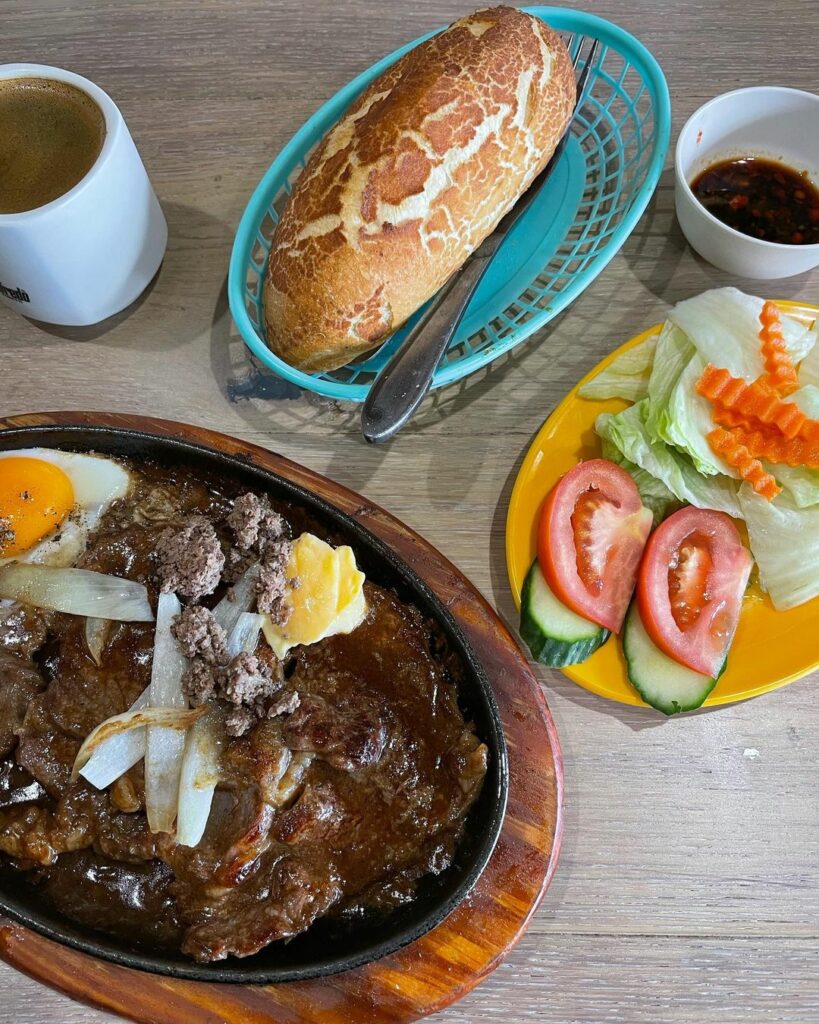
Bo ne and bo ne steak are two different dishes, despite having similar names. Here are the main differences:
| Bo ne | Bo ne steak |
| Bo ne is a Vietnamese dish that consists of thinly sliced beef that is marinated and sautéed on a hot plate or skillet. It is typically served with a fried egg, sliced vegetables such as onions, tomatoes, and cucumbers, and a side of baguette or rice. Bo ne is popular street food in Vietnam and is commonly found on the menu of Vietnamese restaurants. | Bo ne steak, on the other hand, is a fusion dish that combines the flavors of bo ne with a Western-style steak. It typically consists of a steak that is cooked to the desired level of doneness and served with sautéed onions and a fried egg. The steak is often served on a sizzling hot plate, similar to bo ne, but with a larger cut of beef. |
What is the price of 1 piece of bo ne?
The price of one piece of bo ne can vary depending on where you are and the restaurant or street vendor you go to. In Vietnam, bo ne can range from 30,000 to 70,000 Vietnamese Dong per serving, which is roughly equivalent to $1.30 to $3.00 USD.
In other countries, the price may be higher due to import costs or other factors. It’s always a good idea to check the menu or ask your server for the price before ordering.
Best places to fine bo ne
If you’re looking for the best places to find bo ne here are some options to consider:
In Vietnam
If you’re in Vietnam, here are some cities where you can find delicious bo ne:
- Ho Chi Minh City: Bo ne is popular street food in Ho Chi Minh City, and you can find it at many street vendors or local restaurants. Some popular places to try include Bo ne Phú Nhuận and Bo ne 3T.
- Hanoi: In Hanoi, bo ne is often served with fried potatoes and pâté. Some popular places to try to include bo ne Đình Lễ or bo ne Ngọc Hân.
- Da Nang: Da Nang is also known for its delicious bo ne. Some popular places to try include bo ne Hương Giang or bo ne Sài Gòn.
- Other Cities: Bo ne is a popular dish throughout Vietnam, so you can find it in many other cities as well. Check local food markets, street vendors, or restaurants for the best options.
If you’re searching for “Bo ne Vietnamese near me” in Vietnam, try using Google Maps or other local search engines to find nearby restaurants or street vendors that serve bo ne.
In the US
If you’re in the US, here are some popular places to find bo ne:
- Bo Ne Houston: Houston has a thriving Vietnamese food scene, and you can find delicious Bò Né at many local restaurants. Some popular places to try include Thien An Sandwiches or Cali Sandwich & Fast Food.
- Bo Ne Katy: Katy, Texas is also known for its delicious Vietnamese food, including bo ne.
- Yummy Pho Bo Ne: Yummy Pho Bo Ne is a popular Vietnamese restaurant with multiple locations throughout the US. They offer a delicious bo ne on their menu, along with other traditional Vietnamese dishes.
Some popular places to try include Pho Katy or Tiger Noodle House. If you’re searching for “bo ne near me” in the US, try using Google Maps or other local search engines to find nearby Vietnamese restaurants that serve bo ne.
More beef recipes
- Exploring Bo Kho – Vietnam’s Delicious Beef Stew
- Step-by-Step Instructions for Creating the Perfect Beef Rendang Banh Mi
FAQs
Are there any health benefits to bo ne?
Bo ne is a dish that is high in protein from beef and egg, and it also contains a variety of vegetables and herbs that provide essential vitamins and minerals. However, bo ne is also typically high in sodium and fat, so it should be consumed in moderation as part of a balanced diet.
Is bo ne a popular dish internationally?
While bo ne is popular street food in Vietnam, it may not be as well-known internationally. However, with the rise in popularity of Vietnamese cuisine, bo ne is starting to gain recognition as a delicious and unique dish that offers a sizzling and flavorful eating experience.
What time frame will bo ne be sold in Vietnam?
Bo ne is typically served all day, from breakfast to dinner. It is popular street food in Vietnam that can be found at food markets, street vendors, or local restaurants. In some areas, Bo ne may be more commonly sold in the morning or at night, but it is generally available throughout the day.
Is bo ne a spicy dish?
It depends on the recipe and the individual’s preference, but bo ne can be made to be a spicy dish by adding chili peppers or other spices. However, not all bo ne dishes are spicy, and some may be milder in flavor.
What type of meat is typically used in bo ne?
The type of meat typically used in bo ne is beef, specifically bone-in ribeye or sirloin steak. The bone is usually left in during cooking to add flavor to the broth. However, some variations of bo ne may use other cuts of beef.
How long does it take to make bo ne from scratch?
It is unlikely that you can make bo ne from scratch in 30 minutes. The dish requires simmering the bone-in meat in a broth for a prolonged period to ensure that the meat becomes tender and the flavors develop. Depending on the recipe and the cut of meat used, bo ne can take several hours to prepare.
What type of bread is typically served with bo ne?
In Vietnam, bo ne is typically served with a type of Vietnamese baguette. This bread is known for its light and crispy crust and soft interior. It is usually sliced lengthwise and used to make a sandwich with the ingredients from the bo ne skillet. The bread is often toasted or warmed before serving to make it even more delicious.
Is bo ne a dish that is meant to be shared or eaten individually?
Bo ne can be served either as an individual dish or as a shared dish for a group. When served individually, each diner will have their own skillet with the ingredients, while in a group setting, a larger skillet will be used and diners can share the ingredients.
The dish is usually accompanied by a side of bread, which can also be shared or served individually. Ultimately, it depends on the specific restaurant or home cook’s preference on how they want to serve bo ne.
Is bo ne a traditional dish for any Vietnamese holidays or celebrations?
Bo ne is not specifically a traditional dish for any Vietnamese holidays or celebrations. However, it is a popular dish that can be enjoyed for special occasions or gatherings with friends and family.
It is also commonly served in Vietnamese restaurants and street food stalls throughout the year, so it can be enjoyed anytime as a delicious and satisfying meal.
Is bo ne a dish that is commonly eaten for breakfast in Vietnam?
Bo ne is typically eaten for breakfast in Vietnam, and it is more commonly eaten for dinner. Vietnamese breakfast dishes usually consist of lighter fare such as “phở” (rice noodle soup) or “bánh mì” (Vietnamese sandwich), which are more suitable for the morning meal. However, bo ne can be enjoyed any time of the day as a hearty and delicious meal.
What are some common toppings for bo ne?
Some common toppings for bo ne include sliced onions, green onions, tomatoes, and mushrooms. The dish may also be garnished with cilantro, basil, or other herbs for added flavor.
Some versions of bo ne may also include other toppings, such as sliced bell peppers or tofu. Additionally, chili peppers or chili sauce can be added for those who prefer a spicier flavor. The toppings and garnishes may vary depending on the specific recipe or personal preferences.
Conclusion
In the analysis, bo ne is a flavorful and sizzling Vietnamese dish that offers a unique eating experience. With its thinly sliced beef that is marinated and sauteed on a hot plate or skillet, along with a fried egg, sliced vegetables, and a side of bread or rice, bo ne captures the essence of Vietnamese cuisine. While it may not be as well-known internationally.
With its variations in cuts of beef, regional flavors, and even vegetarian options, there’s a bo ne for everyone to enjoy. Whether you’re in Vietnam or trying to recreate the dish at home, following the right steps and avoiding common mistakes can help you achieve the perfect bo ne. So go ahead and savor the flavors of bo ne, and discover why it’s become a beloved dish in Vietnamese cuisine.